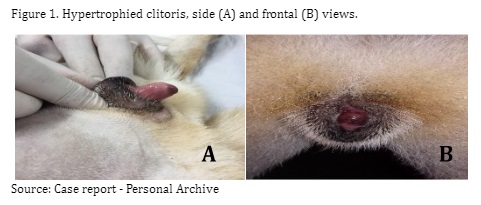Male pseudohermaphroditism in a dog: case report
DOI:
https://doi.org/10.21708/avb.2023.17.4.11795Abstract
Genital development disorders or anomalies have been described in several species of domestic animals. Sexual differentiation in mammals occurs sequentially and chronologically with the following distinct events in embryonic and faetal development: the determination of chromosomal sex at fertilisation, the development of gonadal sex and, finally, the development of the phenotypic sex in the foetus. Any errors in these processes lead to some form of intersexuality. In the literature, three types of intersexuality in companion animals are described: true hermaphroditism and male and female pseudohermaphroditism. The diagnosis is based on physical and imaging examinations, with confirmation by histopathological analysis and karyotyping. As there are few reports of this sexual anomaly, this case report addresses a case of male pseudohermaphroditism in a Shiba Inu canine. Clinical examination revealed the presence of a hypertrophied clitoris in the vaginal canal, without obstruction of the urethral canal. An abdominal ultrasound examination revealed splenomegaly, signs suggestive of chronic cystitis associated with bladder and urethral microuroliths, as well as a small tubular structure without cranial continuity. A blood count, serum biochemistry and the determination of the hormonal levels were performed pre- and post-surgery. Surgical treatment was instituted through exploratory laparotomy, revealing the presence of testicles in the abdominal cavity, a uterus, a cervix and uterine horns. The findings were sent for histopathological analysis, where diffuse testicular hypoplasia and endometrial hyperplasia, associated with neutrophilic and lymphoplasmacytic metritis, were evaluated. As these findings are associated with anamnesis, it is concluded that this case is a male pseudohermaphrodite.
Downloads

Downloads
Published
Issue
Section
License
Copyright (c) 2024 Acta Veterinaria Brasilica

This work is licensed under a Creative Commons Attribution 4.0 International License.
Autores que publicam na Acta Veterinaria Brasilica concordam com os seguintes termos: a) Autores mantém os direitos autorais e concedem à revista o direito de primeira publicação, com o trabalho simultaneamente licenciado sob a Licença Creative Commons Attribution que permite o compartilhamento do trabalho com reconhecimento da autoria e publicação inicial nesta revista. b) Autores têm autorização para assumir contratos adicionais separadamente, para distribuição não-exclusiva da versão do trabalho publicada nesta revista (ex.: publicar em repositório institucional ou como capítulo de livro), com reconhecimento de autoria e publicação inicial nesta revista. c) Autores têm permissão e são estimulados a publicar e distribuir seu trabalho online (ex.: em repositórios institucionais ou na sua página pessoal) a qualquer ponto antes ou durante o processo editorial, já que isso pode gerar alterações produtivas, bem como aumentar o impacto e a citação do trabalho publicado (Veja O Efeito do Acesso Livre).


 Esta obra está licenciada com uma Licença
Esta obra está licenciada com uma Licença 